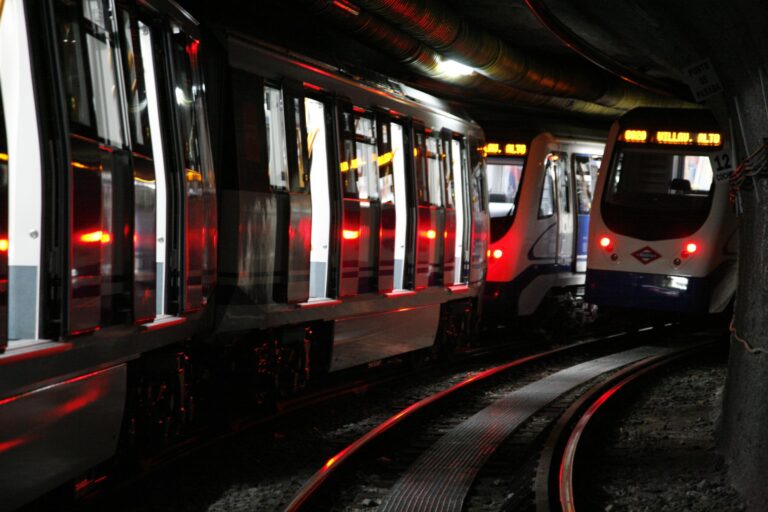An Italian start-up wants to transform the railway industry into a clean energy powerhouse by redesigning its tracks.Greenrail, backed by EU funding, have developed an energy-generating sleeper, the rectangular part between railroad tracks. Normally made from concrete, this version will be produced using recycled materials and feature a small solar panel.It can also integrate a kinetic energy system that generates electricity from the pressure of trains passing by. If over 20 trains pass each hour, this could provide a minimum of 70 kWh per kilometre.The true potential of this product emerges when you consider 1 600 sleepers could fit in one kilometre of railway track and that most EU countries have tracks spanning thousands of kilometres. Germany alone has over 41 328 kilometres.Most of these sleepers are made from energy-intensive concrete, but Greenrail’s version takes a much more sustainable approach.‘It’s the only sleeper in the world made from recycled plastic and end-of-life tyres,’ said Emanuele Occhipinti from the R&D department at Greenrail.For each kilometre of Greenrail’s sleepers, more than 30 tonnes of each of these materials will be reused. A single sleeper can be used for 50 years before it needs to be replaced, at which stage it can be recycled again.According to Occhipinti, the system will cost, on average, 15-20 % less per kilometre than traditional sleepers.Greenrail’s sleepers use recycled materials and small solar panels to provide an environmentally friendly alternative to the common concrete version. Image courtesy of GreenrailGreenrail is about to enter its prototype phase, with the Italian business already receiving interest to take their sleepers to the next level.‘We have obtained several letters of intention from national railway companies that are ready to put our sleepers in a railway for a test,’ said Lorenzo Alessi, Greenrail’s head of marketing and communications. ‘We will start in Italy, but the market is worldwide.’TrainsAbout nine billion trips per year and 12 % of all freight traffic in the EU are made possible by trains. This figure is expected to grow in the coming years meaning we need more trains.‘The challenges are to increase the capacity and operational reliability of the railway system while improving energy efficiency and noise emissions,’ said Dr Eulalia Peris, project coordinator at ROLL2RAIL, an EU-funded project aiming to develop key technologies for Europe’s future railways.‘We are researching traction systems, train communication systems, car body shells, running gear technology, brakes, train interiors, noise and energy performance.’“‘We aim to revolutionise the rolling stock of trains.’Dr Eulalia Peris, UNIFE, BelgiumRailways are reliant on the energy grid, which is mostly powered by fossil fuels. Until the input comes from renewables the industry must try to make their trains more energy efficient.‘We want to quantify how much energy each component (of a train) is using. This way you can know which ones are using the most and optimise them,’ said Dr Peris, who works at UNIFE, the Association of the European Rail Industry, in Belgium.One area that ROLL2RAIL is exploring is new lightweight materials for a train’s car body shell.‘It will allow a reduction in weight which would result in reduced power consumption, lower inertia, less track wear and the ability to carry greater payloads,’ said Dr Peris.They are also investigating more energy efficient, better performing, lighter, quieter and less bulky traction systems.This will link with the project’s work in improving the use of resources when building trains. For example, there are huge amounts of cabling used to wire each carriage.‘We are trying to develop new wireless technologies for train control, for example, in the coupling of passenger coaches and trains,’ said Dr Peris.Wear and tearAnother source of huge resource and energy use is in the lifecycle of trains. Some parts of trains can last 35 years, while others undergo wear and tear at such a rate that they need to be replaced on a regular basis, which costs money, time, energy and materials.‘For instance brakes are a part of a train that need to be inspected regularly as they wear out every time the train brakes,’ said Dr Peris. ‘The train interiors can last a lot of years, but the brakes and wheels wear out very fast.’One solution could be ‘eddy current’ brakes, which slow the train using an electromagnetic force. These don’t require any physical interaction, ensuring that the lifecycle of brakes last much longer.It’s ROLL2RAIL’s mission to address each of these components and make it more efficient than its predecessors. In fact, the project will pave the way for the Shift2Rail initiative that is aiming to double Europe’s railway capacity and lead into a Single European Railway Area.‘We have a consortium comprised of train manufacturers, infrastructure managers, railway operators as well as research centres and universities based in different EU countries,’ said Dr Peris. ‘We aim to revolutionise the rolling stock of trains.’
This article was originally published in Horizon, the EU Research and Innovation magazine.
Add to favorites:
Share:
Listing Description
Video
Documents
No documents available.
Ask KETMarket to make a contact
Connect with the Listing Owner!
💬 Please log in now to askKETMarket to make a contact. Not a member yet? Sign up for free and start connecting today!
Video
Related Funding and Finance Opportunities
Unlock Exclusive Funding Opportunities!
🔑 Get instant access to tailored funding opportunities that perfectly match your needs. This powerful feature is exclusively available to our premium members—helping you save time, stay ahead of the competition, and secure the right funding faster.
Upgrade to Premium now and never miss an important opportunity again! Already a premium member? Log in here to explore your matches.
Related Innovation Offers
Discover Tailored Innovation Offers!
🚀 Gain access to technology solutions that match your specific needs and interests—carefully selected to support your innovation goals. These offers are exclusively available to our premium members, helping you identify relevant technologies faster and start the right conversations with potential partners.
Upgrade to Premium now and explore your personalized technology matches today! Already a premium member? Log in here to view your tailored offers.
Related Knowledgeable Resources
Discover More with Premium: Related Knowledge Resources
🔒 You’re missing out on expert-curated knowledge specifically matched to this topic. As a Premium member, you gain exclusive access to in-depth articles, guides, and insights that help you make smarter decisions, faster.
Whether you’re preparing a funding proposal, researching a new market, or just need reliable information—our Premium knowledge matches save you hours of research and point you directly to what matters.
Upgrade to Premium now and instantly unlock relevant knowledge tailored to your needs! Already a member? Log in here to view your personalized content.

